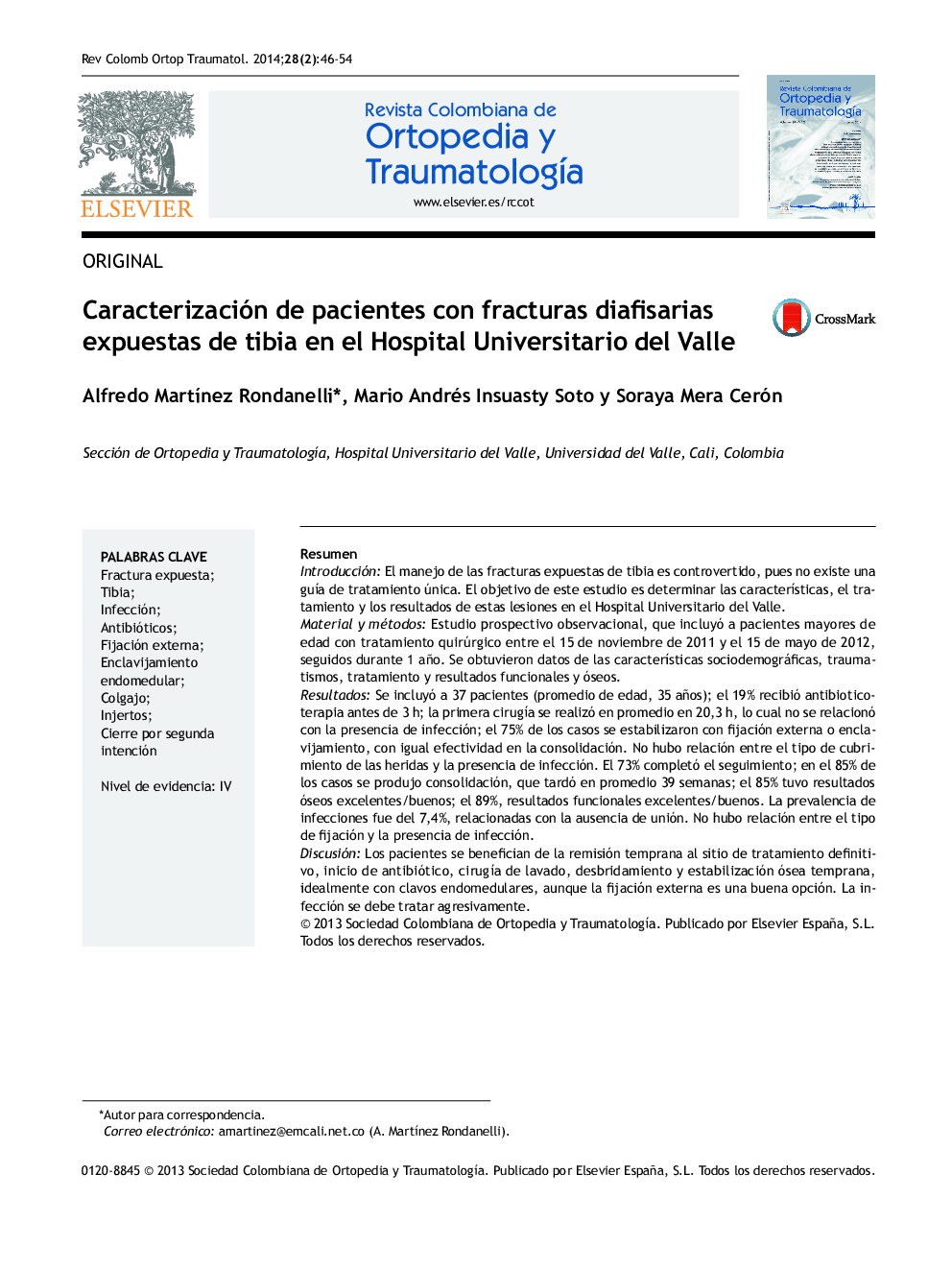| کد مقاله | کد نشریه | سال انتشار | مقاله انگلیسی | نسخه تمام متن |
|---|---|---|---|---|
| 4086031 | 1267920 | 2014 | 9 صفحه PDF | دانلود رایگان |

ResumenIntroducciónEl manejo de las fracturas expuestas de tibia es controvertido, pues no existe una guía de tratamiento única. El objetivo de este estudio es determinar las características, el tratamiento y los resultados de estas lesiones en el Hospital Universitario del Valle.Material y métodosEstudio prospectivo observacional, que incluyó a pacientes mayores de edad con tratamiento quirúrgico entre el 15 de noviembre de 2011 y el 15 de mayo de 2012, seguidos durante 1 año. Se obtuvieron datos de las características sociodemográficas, traumatismos, tratamiento y resultados funcionales y óseos.ResultadosSe incluyó a 37 pacientes (promedio de edad, 35 años); el 19% recibió antibioticoterapia antes de 3 h; la primera cirugía se realizó en promedio en 20,3 h, lo cual no se relacionó con la presencia de infección; el 75% de los casos se estabilizaron con fijación externa o enclavijamiento, con igual efectividad en la consolidación. No hubo relación entre el tipo de cubrimiento de las heridas y la presencia de infección. El 73% completó el seguimiento; en el 85% de los casos se produjo consolidación, que tardó en promedio 39 semanas; el 85% tuvo resultados óseos excelentes/buenos; el 89%, resultados funcionales excelentes/buenos. La prevalencia de infecciones fue del 7,4%, relacionadas con la ausencia de unión. No hubo relación entre el tipo de fijación y la presencia de infección.DiscusiónLos pacientes se benefician de la remisión temprana al sitio de tratamiento definitivo, inicio de antibiótico, cirugía de lavado, desbridamiento y estabilización ósea temprana, idealmente con clavos endomedulares, aunque la fijación externa es una buena opción. La infección se debe tratar agresivamente.
BackgroundThe management of open tibial fractures is controversial, as there is no single treatment guide. The aim of this study was to determine the characteristics, treatment and outcomes of this disease in the Hospital Universitario del Valle.Material and methodsA prospective, observational study was conducted that included adult patients surgically treated between November 15, 2011 and May 15, 2012, followed-up for at least one year. The data recorded included sociodemographic characteristics, trauma, treatment, and functional and bone results.ResultsA total of 37 patients, with a mean age 35 years were included. Antibiotic therapy was given in 19% within three hours. The first surgery was performed in a mean of 20.3 hours after trauma, and was not associated with the presence of infection. Stabilization with external fixation or intramedullary nailing was performed in 75% of cases, with equal effectiveness in consolidation. There was no relationship between the type of fixation and the presence of infection. Follow-up was completed by 73%, and 85% of fractures were consolidated within a mean of 39 weeks, with 85% having excellent/good bone results, and 89% with excellent/good functional results. The prevalence of infection was 7.4% and highly related to nonunion. There was no relationship between the type of fixation and the presence of infection.DiscussionPatients will benefit from early referral to a definitive institution of treatment, the early beginning antibiotic therapy, early surgical debridement and bone stabilization, ideally with intramedullary nails though external fixation as a good choice. The infection should be treated aggressively.
Journal: Revista Colombiana de Ortopedia y Traumatología - Volume 28, Issue 2, June 2014, Pages 46–54